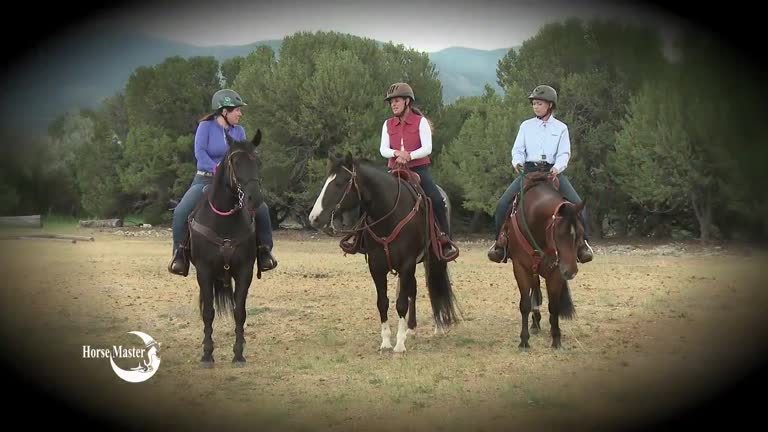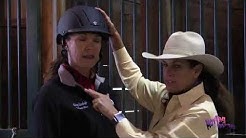It’s hard to believe that the holidays are almost over. That means I’ll be back on the road again soon, heading to Wellington, Florida next weekend for the first “Helmet Symposium.” It’s a big summit meeting of industry professionals that presumably have an influence over whether or not riders wear helmets and I’ve been invited, I guess because I am one of the few people that do what I do wearing a helmet.
It’s interesting to look at the evolution of helmet wearing in this industry and the stubborn resistance, especially when you compare it to other sports. I grew up in Florida, initially a “backyard” rider (mostly riding bareback, barefoot and often in my bathing suit—we didn’t even own a helmet back then, no one did). Later in the 60s, I started taking English riding lessons and eventually got involved in the hunter/jumper world, and we had to wear “hard hats” whenever jumping (at least when an adult was watching). I remember my favorite hard hat well, in fact, I still have it. It’s a thin plastic shell covered with black velvet—no chin strap and a very rigid visor that was notorious for slamming down and breaking your nose if you fell. There was no chin harness like we know of today, but there was a little elastic band that you could pull down if you wanted to look like a total geek (I cut the elastic off of mine). Most people preferred to leave the elastic off in the hopes that the hard hat would come off if you fell, instead of breaking your nose. Back then, helmets had almost no protective value and might actually do more harm than good.
Eventually technology and research caught up and by the 1980s they started making certified equestrian helmets that actually served a purpose and protected the head in the event something went wrong. Dr. Richard Timms, a critical care physician and researcher, whose career ambitions included PREVENTING injury rather than just treating it, was instrumental in promoting the use of equestrian helmets, even though he was not a rider. Working with a safety product company called Troxel, which started out making infant car seats (before anyone else did), then bicycle helmets and eventually, with Dr. Timm’s insistence, Troxel became the first manufacturer of certified riding helmets. Now, riding helmets is all Troxel does and it is the leading producer of equestrian helmets and is known for their innovation and unique styles.
Today, helmets are not only safe, but they are comfortable, well-fitted and even stylish. So why then is there still such a resistance to wearing a helmet when you ride? You wouldn’t dream of getting in your car and going somewhere without fastening your seat belt, even though you are not planning to have a wreck today. Add to the equation the fact that when you are riding your head is higher off the ground than almost any other sport and you are sitting an unpredictable, potentially volatile animal and it seems like a no-brainer (pardon the pun).
It’s been interesting to watch the evolution of helmet wearing in other sports. When we were kids, no one wore a helmet when cycling; today, a serious cyclist wouldn’t be caught dead without one—wearing a helmet is part of the accepted and cool gear in extreme sports like mountain biking. Riding is just as dangerous as motorcycling in injuries per minute of riding and most people on motorcycles wear helmets, yet only one in eight equestrians do.
Fifteen years ago skiers and snowboarders never wore helmets; but then in 1998 two tragedies occurred within one week of each other and two famous people were killed from head injuries while skiing—Michael Kennedy (son of the late Senator Robert Kennedy) and Senator Bono(of Sonny and Cher fame). Although it’s questionable whether or not a helmet would’ve actually helped in these high-speed tree collision accidents, literally overnight we started seeing more skiers wearing helmets and the ski helmet market exploded. Today, more skiers than not wear helmets and it has become an essential piece of cool equipment that serious/hardcore skiers and snowboarders always wear. Even my husband, a professional skier for more than 35 years, now wears a helmet every time he skis, although he still doesn’t wear one riding.
So what is it about us equestrians that makes us so dang stubborn about wearing protective gear? It’s definitely much more readily accepted amongst the English crowd, with persistent stubborn resistance from the Western crowd. I guess we just loathe to give up our cowboy hats. What do you think is the big reason why riders are resistant to helmet wearing? Is it ego? Do you think it makes you looks weak or afraid? Is it because there are not good role models in this sport? Is it because you don’t think you need one because your horse is so reliable? Is it because helmets are uncomfortable or ugly? What’s your reason? If you do wear a helmet, why? How did you make that decision? These are all questions that will be addressed in the upcoming helmet summit that I will be attending next month. I’d love to see your comments and take them with me to the meeting.
Happy New Year!
Julie


